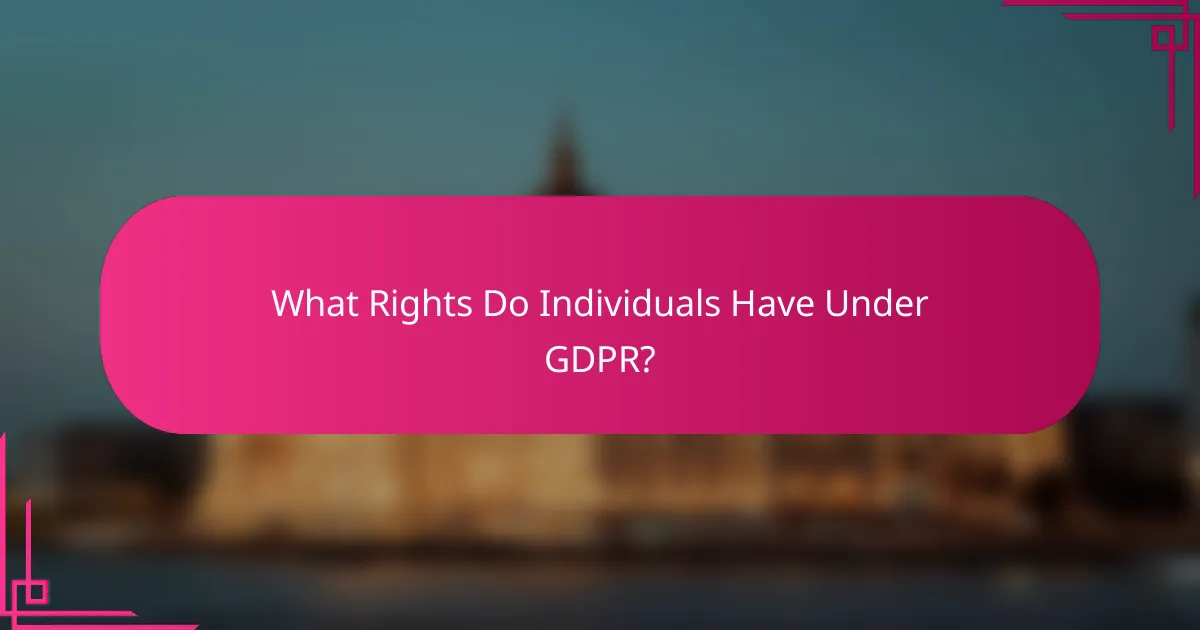The General Data Protection Regulation (GDPR) establishes essential principles for the processing of personal data, ensuring that individuals’ rights are safeguarded while enabling organizations to manage data responsibly. Compliance requires organizations to adopt specific practices, such as conducting assessments and embedding privacy into their processes. Individuals are empowered with rights that allow them to access, correct, delete, transfer, and object to the processing of their personal data.

How to Achieve GDPR Compliance in the UK?
To achieve GDPR compliance in the UK, organizations must implement specific practices that protect personal data and uphold individuals’ rights. This includes conducting thorough assessments, embedding privacy into processes, and regularly reviewing compliance measures.
Data Protection Impact Assessments
Data Protection Impact Assessments (DPIAs) are essential for identifying and mitigating risks associated with data processing activities. Organizations should conduct DPIAs when initiating new projects that involve personal data, especially if they are likely to result in high risks to individuals’ rights and freedoms.
A DPIA should outline the nature of data processing, assess potential impacts, and detail measures to address risks. This proactive approach not only aligns with GDPR requirements but also fosters trust with stakeholders.
Implementing Privacy by Design
Privacy by Design is a principle that requires organizations to integrate data protection into their systems and processes from the outset. This means considering privacy implications during the development of any new product or service.
To implement this effectively, organizations should conduct regular reviews of their data handling practices and ensure that data minimization is a key focus. For example, only collecting data that is necessary for a specific purpose can significantly reduce privacy risks.
Regular Compliance Audits
Conducting regular compliance audits helps organizations assess their adherence to GDPR principles and identify areas for improvement. These audits should evaluate data processing activities, security measures, and staff compliance with data protection policies.
Audits can be scheduled annually or biannually, depending on the size and complexity of the organization. Utilizing checklists can streamline the audit process and ensure that all aspects of GDPR compliance are covered.
Staff Training Programs
Implementing staff training programs is crucial for fostering a culture of data protection within an organization. Employees should be educated on GDPR principles, data handling procedures, and the importance of safeguarding personal information.
Training sessions can include practical scenarios and role-playing to help staff understand their responsibilities. Regular refresher courses will keep data protection top of mind and help mitigate risks associated with human error.
Utilizing GDPR Compliance Tools
GDPR compliance tools can assist organizations in managing data protection responsibilities more efficiently. These tools range from software solutions that automate data mapping to platforms that facilitate consent management and breach reporting.
When selecting compliance tools, organizations should consider their specific needs and the scale of their data processing activities. Many tools offer features that simplify compliance tasks, such as tracking data subject requests and maintaining records of processing activities.

What are the Key Principles of GDPR?
The General Data Protection Regulation (GDPR) is built on several key principles that guide the processing of personal data. These principles ensure that individuals’ rights are protected while allowing organizations to handle data responsibly and transparently.
Lawfulness, Fairness, and Transparency
Data processing must be lawful, fair, and transparent to the data subjects. Organizations should have a valid legal basis for processing personal data, such as consent or contractual necessity, and must inform individuals about how their data will be used.
To ensure transparency, companies should provide clear privacy notices that outline the purpose of data collection, the types of data collected, and the rights of individuals regarding their data. This helps build trust and accountability.
Purpose Limitation
Data should only be collected for specified, legitimate purposes and not further processed in a manner incompatible with those purposes. This means organizations must define the reasons for data collection clearly and ensure that any subsequent use aligns with those reasons.
For example, if data is collected for marketing purposes, it cannot be used for unrelated activities like profiling without additional consent. This principle helps prevent misuse of personal data and protects individual privacy.
Data Minimization
The principle of data minimization states that organizations should only collect and process the minimum amount of personal data necessary to achieve their intended purpose. This reduces the risk of data breaches and enhances privacy protection.
Practically, this means avoiding excessive data collection. For instance, if only an email address is needed for a newsletter, collecting additional information like phone numbers or addresses would violate this principle.
Accuracy
Organizations are required to take reasonable steps to ensure that personal data is accurate and kept up to date. This is crucial because inaccurate data can lead to incorrect decisions and harm individuals.
To comply, businesses should implement regular reviews and updates of their data. For example, if a customer changes their address, the organization must update its records promptly to maintain accuracy.
Storage Limitation
Personal data should not be stored for longer than necessary for the purposes for which it was collected. This principle encourages organizations to establish clear retention policies and procedures for data deletion.
For instance, if a company collects data for a specific project, it should set a timeline for data deletion once the project is completed. This helps minimize the risk of unauthorized access or data breaches over time.
Integrity and Confidentiality
Organizations must ensure that personal data is processed securely, protecting it against unauthorized access, loss, or damage. This involves implementing appropriate technical and organizational measures to safeguard data integrity and confidentiality.
Examples include using encryption, access controls, and regular security audits. Companies should also train employees on data protection practices to foster a culture of security and compliance.

What Rights Do Individuals Have Under GDPR?
Under the General Data Protection Regulation (GDPR), individuals have several rights that empower them to control their personal data. These rights include access to their data, the ability to correct inaccuracies, the option to request deletion, the right to transfer data, and the ability to object to processing.
Right to Access
The Right to Access allows individuals to request copies of their personal data held by organizations. This means that individuals can inquire about what data is collected, how it is used, and who it is shared with.
Organizations must respond to access requests within one month, providing the requested information free of charge. It is advisable for individuals to keep records of their requests and responses for future reference.
Right to Rectification
The Right to Rectification enables individuals to correct inaccurate or incomplete personal data. If a person finds that their data is incorrect, they can request that the organization amend it.
Organizations are required to act on rectification requests without undue delay, typically within one month. Individuals should provide clear information about what needs to be corrected to facilitate the process.
Right to Erasure
The Right to Erasure, often referred to as the “right to be forgotten,” allows individuals to request the deletion of their personal data under certain conditions. This right can be exercised when the data is no longer necessary for the purposes for which it was collected or if the individual withdraws consent.
Organizations must evaluate each request and respond within one month. It’s important for individuals to understand that this right is not absolute and may be subject to exceptions, such as legal obligations to retain data.
Right to Data Portability
The Right to Data Portability gives individuals the ability to obtain and reuse their personal data across different services. This right applies when the data is processed based on consent or a contract and is carried out by automated means.
Individuals can request their data in a structured, commonly used, and machine-readable format, making it easier to transfer to another service provider. Organizations must comply with these requests within one month.
Right to Object
The Right to Object allows individuals to challenge the processing of their personal data in certain circumstances, particularly when data is used for direct marketing purposes. Individuals can object to the processing at any time, and organizations must stop processing the data unless they can demonstrate compelling legitimate grounds.
To exercise this right, individuals should clearly communicate their objection and the reasons behind it. Organizations are required to inform individuals of their right to object at the time of data collection.
